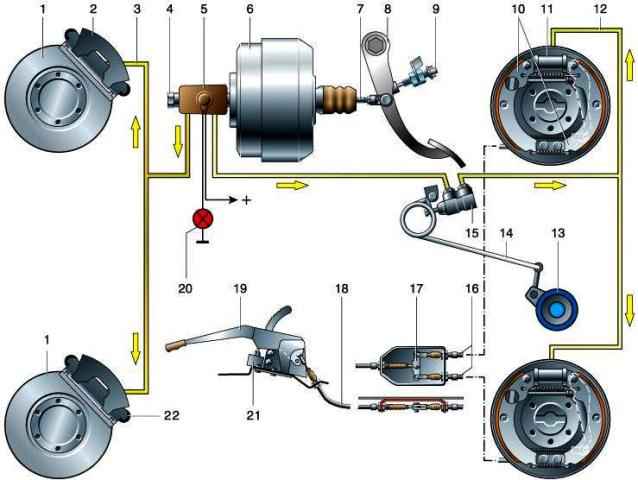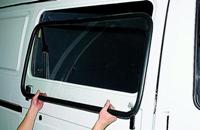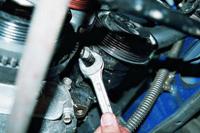The car has three independent brake systems: working, spare and parking
The working brake system is hydraulic, dual-circuit (divided into front and rear circuits), with a vacuum booster, pressure regulator and an emergency drop sensor in the brake fluid level in the reservoir.

Scheme of the brakes of a Gazelle car; 1 - brake disc; 2 - front wheel brake caliper; 3 - front contour; 4 - main brake cylinder; 5 - a reservoir with a sensor for an emergency drop in the level of brake fluid; 6 - vacuum amplifier; 7 - pusher; 8 - brake pedal; 9 - brake signal switch; 10 - brake pads of the rear wheels; 11 - brake cylinder of the rear wheels; 12 - rear contour; 13 - casing of the rear axle shaft; 14 - load spring; 15 - pressure regulator; 16 - rear cables; 17 - equalizer; 18 - front (central) cable; 19 - parking brake lever; 20 - signaling device for an emergency drop in the level of brake fluid; 21 - parking brake indicator switch; 22 - front wheel brake shoe
A spare system is formed by each circuit of the working one.
If one of the circuits of the brake system fails, the second circuit provides braking of the car, albeit with less efficiency.
The parking system is mechanical, with a cable drive from a hand lever to the brake pads of the rear wheels.
The brake mechanisms of the front wheels are disc, with a single-piston floating caliper (when braking, the piston presses the inner pad against the disc, and the caliper, moving in the opposite direction, presses the outer pad).
The minimum allowable residual thickness of the front brake pads is 3 mm.
The discs are ventilated, mounted on the hubs and attached to them with six bolts.
The minimum allowable thickness of a worn disc is 19 mm.
The bracket consists of a base, which is fastened with two bolts to the steering knuckle and a body connected to the base through guide pins.
The brake cylinder is made in the caliper body; on the outside, it is covered with a rubber boot (dust boot) to protect it from dirt.
Inside the cylinder there is a groove into which an o-ring (cuff) is inserted.
When the piston moves out of the cylinder during braking, this ring twists slightly and, after braking, tends to return the piston to its original position.
This maintains a constant minimum clearance between the disc and the brake pads.
The cylinder has a valve for bleeding the system.
Brake mechanisms of the rear wheels are drum, with two-piston wheel cylinders and automatic adjustment of the gap between the pads and the drum.
Thrust rings are inserted into the cylinder with an interference fit, limiting the free travel of the pistons (after braking), thereby maintaining a constant gap between the pads and the drum.
As the pads wear, the rings move by the amount of wear.
At the top of the brake pads are eccentrics to adjust the position of the pads after replacing them.
The minimum allowable thickness of the rear brake pads is 1 mm. The maximum permissible inner diameter of the brake drum is 283 mm.
The main brake cylinder with a two-section reservoir and an emergency drop in brake fluid level sensor is attached to the vacuum booster.
The pistons in the cylinder are arranged in series, the one closest to the vacuum booster actuates the brake mechanisms of the rear wheels, the other piston - the front ones.
In the absence of fluid leaks, its level in the reservoir of the main brake cylinder should be between the MAX and MIN marks.
The level will decrease as the brake pads wear.
In the event of a leak in the brake system, a sensor is triggered and a red indicator lamp lights up on the instrument panel.
In this case, you can add liquid only after the malfunction has been eliminated.
The vacuum booster is located between the pedal assembly and the main brake cylinder and is attached to the bracket with four studs.
To increase the braking force, a vacuum is used in the intake pipe of the engine, to which the booster is connected by a hose.
The amplifier is of a non-separable design; in case of failure, it is replaced. The pressure regulator is attached to the left side member of the frame.
It adjusts the brake fluid pressure in the rear wheel brake circuit, depending on the vehicle load, which improves directional stability when braking.
By monitoring rear axle loading through the load spring, it limits the fluid pressure in the rear brake circuit.
In case of failure, the regulator is replaced.
After replacing the regulator or elements rear suspension, the position of the load spring relative to the rear axle must be re-adjusted.
Possible brake failures
- Cause of malfunction
elimination method
Increased brake pedal travel:
Presence of air in the hydraulic drive system
Bleed the system
- The thrust ring of the piston of the rear wheel cylinder has lost its elasticity and, under the action of the return spring of the brake pads, moves inside the cylinder together with the piston
Replace the wheel cylinder assembly - article Replacing the brake cylinder of the rear wheels
- Violation of the tightness of the brake system (liquid leak)
Locate the location of the fluid leak and replace the parts that affect the leak. Bleed the brake system - article "How to change the brake fluid and bleed brake system"
In case of leaks in pipeline connections, tighten connections or replace seals
- Increased clearance between the head of the vacuum booster adjusting bolt and the master cylinder piston
See Replacing the vacuum brake booster of a Gazelle car
The brake pedal slowly moves down with the same force on it and the parking brake is applied:
- Cuff damage
Replace damaged cuff
The brake mechanisms of all wheels or axles are not fully released (high-hanging wheels turn slowly):
- Lack of clearance between the head of the vacuum booster adjusting bolt and the master cylinder piston
See Vacuum booster
- Incomplete return of the brake pedal after braking due to incorrect installation of the brake light switch
Set the gap (8+1) mm between the plastic tip of the brake light switch and the stop on the pedals
- Clogging of the compensation holes of the main brake cylinder or overlapping of the compensation holes with the edges of the cuffs
Remove the master cylinder reservoir and connecting sleeves.
Clean the compensation holes with a soft wire with a diameter of 0.6 mm.
If at the same time the wire rests against the cuff, then it is necessary to disassemble the main cylinder and replace the swollen cuffs
One brake mechanism does not release (the suspended wheel rotates tightly):
- Jamming of the guide pins at the base of the front brace
Replace or lubricate the guide pins. Replace damaged finger covers
- Jamming of the pistons in the brake caliper body
Remove the brake caliper housing from the base, remove dirt and corrosion from the surface of the housing cylinder and lubricate the working surfaces with NG-213 liquid or castor oil (see Repair of the front wheel brake)
- Loss of elasticity of the sealing ring of the brake caliper body
Remove the caliper housing from the base and replace the O-ring
- Jamming pads due to severe contamination of the guide groove of the base
Remove the pads and clean the guide groove and ledges of the base from corrosion and dirt
- Weakening or breakage of the return spring of the rear brake pads
Replace spring
- Jamming of the rear brake pistons due to contamination or corrosion
Disassemble the wheel cylinder, clean the parts from dirt and corrosion, rinse, replace the mud covers
- Swelling of the O-rings of the pistons of the rear wheel cylinder
Change O-rings and brake fluid
- Lack of clearance between the brake lining and the rear brake drum due to incorrect installation of the automatic adjustment thrust ring
Disassemble the wheel cylinder, eliminate the distortion of the thrust ring
Sliding or pulling the car to the side when braking:
- Unequal tire pressure
Readjust tire pressure to normal
- Oiling of friction linings in one of the brake mechanisms
Replace the pads or wash the pads with gasoline, followed by sanding with fine sandpaper and carefully removing abrasive dust from the pad
- Seizures or deep scratches on the surface of the brake disc or drum
Repair or replace the disc or brake drum assembly with hub
- Leakage of brake fluid in one of the front brake mechanisms or wheel cylinders
Fix the leak
- The rear wheels are blocked before the front ones due to a malfunction of the pressure regulator or improper adjustment of its drive
Adjust or replace pressure regulator
Insufficient braking performance (increased effort on the brake pedal):
- Wear or oiling of the brake pads
Replace or wash brake pads
- Incomplete fit of the pads to the drum in the rear brake mechanisms
Clean up the protruding areas of the overlays. Replace pads if necessary
- Leakage in the vacuum hose connection
Restore the tightness of the connection
- The filter of the vacuum brake booster is dirty
Wash the filter or replace with a new one
- Broken brake booster diaphragm
Replace Aperture
- Sealing cuffs of the vacuum brake booster do not provide tightness
Replace the seals and clean the cylindrical working surfaces of the valve body and connector
- Violation of tightness in the connection of the cover with the body of the vacuum booster
Restore tightness
- Violation of tightness in the connection of the vacuum booster with the main cylinder body
Replace O-ring
- Failure of the vacuum booster as a result of the ingress of brake fluid into the cavity of the vacuum booster
Replace the master cylinder seals, remove fluid from the amplifier and replace the diaphragm
Rattle in the brakes:
- Ovality or runout of the working surface of the brake drums of the rear wheels
To bore the brake drum assembly with the hub or replace it with new ones
- Broken disc brake pad springs
Replace brake pads - article "Replacing the brake drum and shoes"
- Front wheel brake guide pin wear
Replace guide pins
- Wear of the holes for the guide pins in the base of the brake caliper
Replace Base
It takes a lot of force on the parking brake handle to hold the car:
- Jamming of cables in guide shells
Disconnect the cables, clean them of dirt, lubricate the cables and their connections with Liga grease
- Lubricating rear brake pads
Wash pads or replace pads with pads
- Incorrectly adjusted parking brake
Adjust the parking brake actuator
Large stroke of the parking brake lever handle:
- Large free play of the parking brake expansion link in the rear wheel brakes
Adjust the parking brake actuator
Heating of the brake drums when driving without braking:
- Incorrect adjustment of the parking brake expansion link
Adjust the parking brake actuator - article "Repair and adjustment of the parking brake"
- - Reduced level of brake fluid in the reservoir of the main brake cylinder in the absence of external leakage in the hydraulic drive
- - Wear or swelling of the outer cuff of the main brake cylinder
Remove the master cylinder and replace the seal.
Drain the brake fluid from the vacuum booster cover











